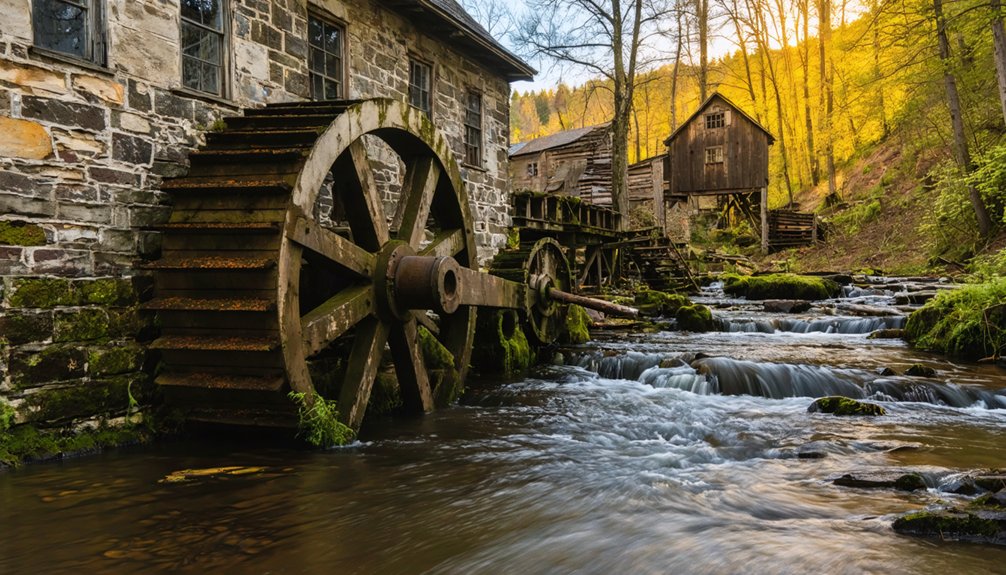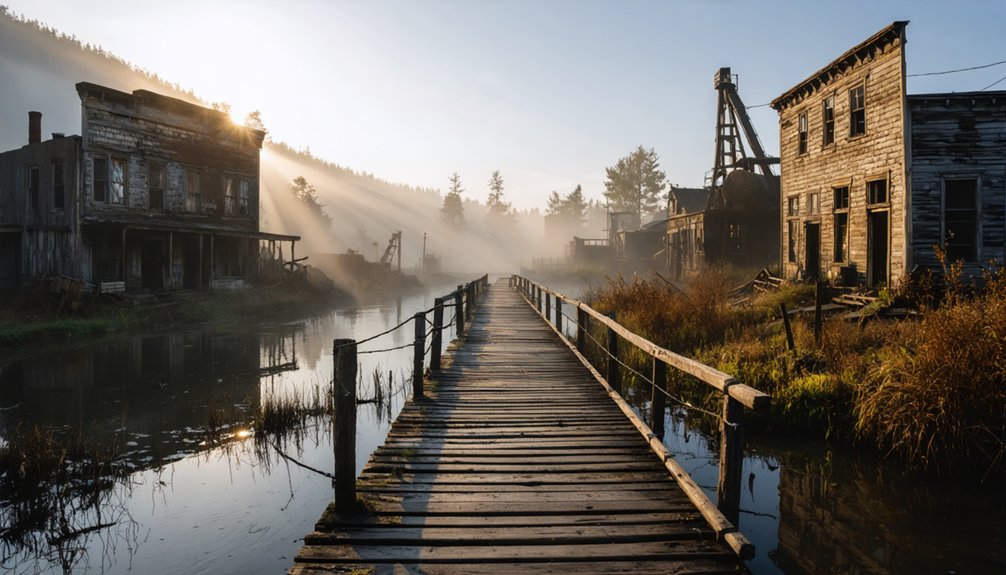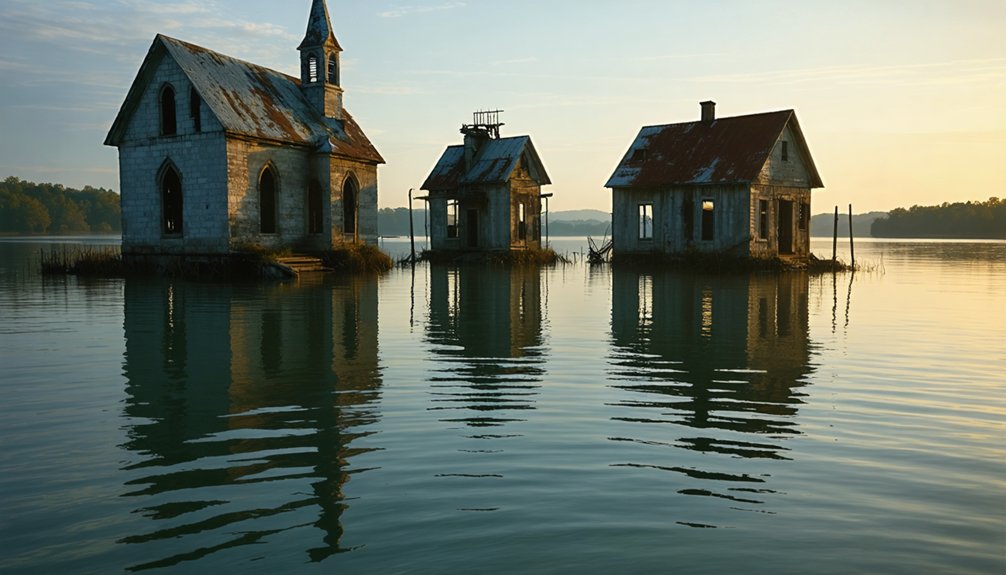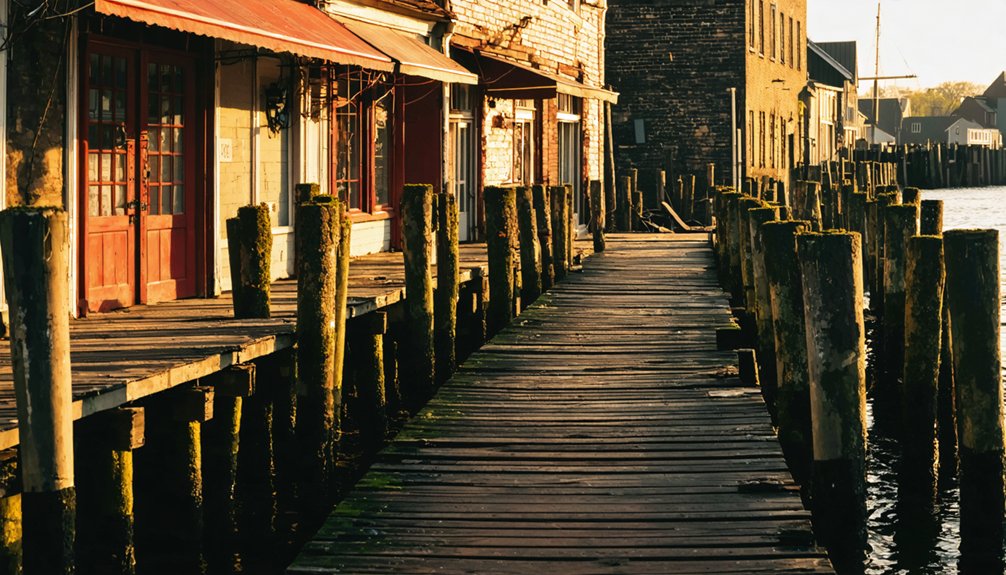You’ll discover America’s most fascinating riverside ghost towns in these seven abandoned settlements: Bodie (California) along Bodie Creek, Bannack (Montana) beside Grasshopper Creek, Ruby (Arizona) near the Santa Cruz River, South Pass City (Wyoming) by the Sweetwater River, Calico (California) proximate to the Mojave River, Johnsonville Village (Connecticut) on Salmon River, and Blue Heron (Kentucky) alongside the Big South Fork. Each waterway once sustained these communities before their eventual abandonment. Their preserved structures tell compelling stories of American frontier life.
Key Takeaways
- Ruby, Arizona sits beside the Santa Cruz River and once housed 1,200 people during its 1930s mining heyday.
- Bannack, Montana, located along Grasshopper Creek, grew to 10,000 residents after an 1862 gold discovery.
- South Pass City, Wyoming developed alongside the Sweetwater River, which was crucial for its gold mining operations.
- Calico, California utilized the nearby Mojave River for its extensive water infrastructure that supported silver production.
- Bodie, California, situated along Bodie Creek, exemplifies arrested decay with 170 preserved structures from its gold rush era.
Bodie, California: Gold Rush Ruins Along Bodie Creek
Nestled along the banks of Bodie Creek in California’s eastern Sierra Nevada, Bodie stands as America’s quintessential gold rush ghost town, where the dreams of thousands once flourished before vanishing into history.
Named after prospector William Bodey, who perished in a snowstorm before witnessing the town’s 1870s boom, this settlement once housed 7,000-10,000 people and ranked among California’s largest cities.
Bodie history reveals a classic boom-bust narrative—from the 1859 gold discovery to abandonment after the last mine closed in 1942. The town earned a reputation as one of the most notorious settlements with inhabitants known for their rambunctious lifestyle.
The rise and fall of a golden dream, frozen in time since the mines fell silent.
Today, you’ll find 170 structures preserved in “arrested decay,” offering an authentic glimpse of Wild West architecture.
As California’s official gold rush ghost town and a National Historic Landmark, Bodie’s remaining buildings and Standard Mill invite you to walk through America’s best-preserved mining town exactly as its residents left it. Visitors can explore the stamp mill through guided tours offered daily, where over $14 million worth of gold and silver was produced during its 25-year operation.
Bannack, Montana: Where Grasshopper Creek Shaped Mining History
Along the banks of Grasshopper Creek in southwestern Montana, Bannack emerged as one of America’s most notorious gold rush settlements, where the discovery of exceptionally pure gold (99.5% versus the typical 95%) in July 1862 transformed a remote wilderness into a booming frontier town.
Bannack history follows a dramatic arc—first territorial capital, surging to nearly 10,000 residents, then abandoned.
You’ll find buildings that housed Sheriff Henry Plummer, who secretly led the “Innocents” gang while wearing his badge, until vigilantes hanged him in 1864. The Montana Vigilantes formed in December 1863 and executed approximately twenty-four suspected outlaws in their crusade against the rampant lawlessness plaguing the area.
By 1866, Grasshopper Creek’s gold diminished, and when railroads bypassed the town in the 1880s, Bannack’s fate was sealed.
Now preserved as a state park, this riverside ghost town maintains its authentic abandoned character—a reflection of Montana’s wild mining era. Visitors today can explore numerous historical structures including saloons, hotels, and a general store that once served the mining community.
Ruby, Arizona: Copper Town Nestled By The Santa Cruz River
In the shadows of Montana Peak beside the Santa Cruz River, Ruby emerged from its 1870s silver-mining origins as a tribute to Arizona’s boom-and-bust frontier economy.
Originally called Montana Camp, this once-thriving settlement reached 1,200 residents during its 1930s heyday, with a robust infrastructure powering round-the-clock mineral extraction.
Ruby’s mining heritage generated over $10 million in precious metals before its 1940 closure and subsequent abandonment.
Today, you’ll find one of Arizona’s best-preserved ghost towns with over two dozen standing structures.
The town’s violent past has spawned enduring ghost stories—from bullet holes in the courthouse to tales of a cursed mercantile allegedly built over a padre’s grave. The Eagle-Picher Lead Company transformed Ruby into a prosperous mining town in 1926, providing electricity and essential services to its growing population.
While exploring this privately-owned historical treasure, you’ll need permits, but the opportunity to walk through authentic mining history makes the effort worthwhile. Visitors must secure access by filling out a form on the Ruby website, after which they’ll receive a gate code by email from the on-site caretaker.
South Pass City, Wyoming: Sweetwater River’s Forgotten Gold Haven
If you visit South Pass City today, you’ll find Wyoming’s best-preserved ghost town situated alongside the critical Sweetwater River that once supplied water for both daily life and gold processing operations.
The settlement’s explosive growth from 1867-1870 transformed it from a minor military outpost into Wyoming Territory’s largest city with 3,000 residents, all sustained by the river that made mining operations possible in this harsh landscape.
Wander through the remaining two dozen historic structures, including the Smith-Sherlock Store and Carissa Mine buildings, where the rushing waters of Sweetwater Creek still provide the soundtrack to this once-prosperous boomtown that collapsed when the gold veins failed to yield their promised riches. The town holds tremendous historical significance as the place where Esther Hobart Morris became the first woman justice in the United States, breaking barriers in a male-dominated frontier society. Visitors can explore the Sweetwater County Jail, built in 1870, which stands as the oldest jail in Wyoming and showcases the harsh realities of frontier justice.
Gold Miners’ River Lifeline
The Sweetwater River, a serpentine lifeline cutting through Wyoming’s harsh terrain, proved indispensable to South Pass City’s meteoric rise as a gold mining hub in the late 1860s.
You’ll find its tributaries directly linked to the richest gold deposits, where miners established hundreds of claims throughout the district.
River mining operations depended entirely on this water source for survival and productivity.
At the English Tunnel mine, workers painstakingly hand-drilled at a rate of just one foot per day, creating workings that plunged 90+ feet deep.
Gold panning along Sweetwater Creek became both practical necessity and cultural tradition, now commemorated during annual Gold Rush Days celebrations.
Without the Sweetwater’s steady flow, the 3,000 residents who once crowded this boom town—briefly Wyoming Territory’s largest city—would have found themselves abandoned to the wilderness long before gold reserves depleted.
The town’s rapid growth was triggered by a significant gold discovery in 1867 when soldiers from Fort Bridger struck valuable deposits, initiating a rush of miners and families to this frontier settlement.
Today, visitors can experience the authentic frontier atmosphere as original buildings remain perfectly preserved in their historic locations, offering a genuine glimpse into Gold Rush era life.
Sweetwater’s Boom-Bust Cycle
Lurking beneath the romantic facade of South Pass City‘s heyday lies a classic American boom-bust narrative that unfolded along Wyoming Territory’s Sweetwater River in the late 1860s.
You’ll recognize familiar mining community dynamics in this settlement that swelled to 3,000 residents after the Carissa Mine discovery transformed gold prospecting techniques from simple panning to industrial extraction.
The economic trajectory reveals the fragility of frontier prosperity:
- By 1868, the boomtown boasted over 250 buildings with hotels, medical professionals, and ten-plus saloons
- Fort Stambaugh’s 1870 establishment provided critical protection from Native American conflicts
- Within a decade, dwindling gold yields and harsh winters forced mass exodus, leaving businesses shuttered
Unlike many contemporaneous settlements, South Pass City maintained a persistent, if diminished, community presence long after the initial gold fever subsided.
Preserved Riverside Architecture
Nestled alongside the meandering Sweetwater River, South Pass City presents one of America’s most meticulously preserved gold rush architectural landscapes, with over two dozen original structures still standing as silent witnesses to Wyoming Territory’s ambitious frontier past.
You’ll discover architectural significance in the false-fronted commercial buildings, like the 1896 Smith-Sherlock Store and 1890 Carissa Saloon, with their clapboard siding and large display windows.
Vernacular log residences and functional public buildings showcase frontier adaptations to local materials and riverside conditions.
The town’s layout parallels the riverbanks, with historic preservation efforts maintaining period interiors, original hardware, and wooden boardwalks.
The Moses Sturman Stamp Mill demonstrates industrial mining architecture, highlighting the Sweetwater’s economic importance.
Walking tours and interpretive displays illuminate daily life in this remarkable riverfront settlement.
Calico, California: Silver Boomtown Near The Mojave River
When you explore Calico’s silver mining legacy, you’ll witness the remnants of a once-thriving boomtown that produced over $20 million in silver ore (equivalent to half a billion modern dollars) before its decline in the 1890s.
You’ll find evidence of the sophisticated water infrastructure that sustained 3,000-3,500 residents in the harsh Mojave Desert, including systems that supported three hotels, five general stores, and numerous commercial establishments.
The Silver King Mine stands as the most prominent reminder of California’s largest silver producer, where ore initially valued at $400-$500 per ton sparked the rush that transformed the multicolored Calico Mountains into a short-lived but prosperous mining center.
Silver Rush History
Although many ghost towns dot America’s western landscape, few embody the dramatic boom-and-bust cycle of silver mining quite like Calico, California. Discovered in 1881, this mining district quickly became California’s largest silver producer, employing revolutionary silver mining techniques across more than 500 mines.
When you visit this meticulously preserved site, you’ll witness:
- The remnants of the Silver King Mine that produced an astonishing $86 million in silver
- Original stone structures positioned along the narrow mesa between Wall Street and Odessa canyons
- Evidence of the ten-mile narrow-gauge railroad that once transported valuable ore
Ghost town preservation efforts culminated in 2005 when Governor Schwarzenegger proclaimed Calico “California’s Silver Rush Ghost Town,” ensuring this representation of America’s frontier spirit remains accessible to freedom-seeking travelers.
Waterworks And Mining
Beneath the rugged terrain of the Calico Mountains lay an impressive network of over 500 mines that transformed this Mojave Desert outpost into California’s premier silver-producing region.
You’d find advanced mining technology at every turn, with the $250,000 Oro Grande stamp mill representing the cutting edge of 19th-century ore processing.
Water management proved essential in this arid landscape, with processing facilities strategically positioned along the Mojave River.
The narrow-gauge Calico Railroad connected the lucrative Silver King Mine to these riverside operations, while redwood cyanide tanks later enabled silver recovery from mine tailings.
At its peak, this infrastructure supported extraction worth $86 million in silver and $45 million in borax.
Twenty-mule teams and the Santa Fe Railroad transported these riches from what was briefly one of California’s most productive mining districts.
Johnsonville Village, Connecticut: The Flooded Mill Town On Salmon River

Nestled along the convergence of the Moodus and Salmon rivers in Connecticut, Johnsonville Village once thrived as a bustling mill town that harnessed the abundant water power of these waterways. Founded in the early 19th century and named after industrialist Emory Johnson, this industrial heritage site became Connecticut’s twine capital with twelve operational mills at its peak.
You’ll discover a haunting landscape where nature reclaims Victorian and colonial architecture—remnants of a community that collapsed after Neptune Mill’s 1972 lightning strike.
Many report ghostly encounters near the remaining structures:
- The relocated 1876 Gilead Chapel with its spectral wedding ceremonies
- The charred remnants of Neptune Mill, once distinguished by its church-like bell tower
- The abandoned homesteads with their pillared porches silently overlooking the millpond
Blue Heron, Kentucky: The Coal Mining Community Along The Big South Fork
Along the rugged banks of the Big South Fork River in Kentucky’s Cumberland Plateau stands another tribute to America’s abandoned riverside communities.
Blue Heron, a coal mining settlement established in 1937 by Stearns Coal & Lumber Company, operated for 25 years before economic realities forced its closure in 1962.
You’ll find the site preserved as an open-air museum featuring distinctive “ghost structures”—steel skeletons that outline where the original buildings once stood.
These frames recreate the community’s church, store, bathhouse and homes that supported hundreds of residents during its heyday.
The Blue Heron Interpretive Center, established in 1989, offers free access to this piece of community history, where recorded testimonies from former residents breathe life into these skeletal remains—the last whispers of an industrial era that shaped the Cumberland waterways.
Frequently Asked Questions
Are These Ghost Towns Safe to Visit With Children?
Would you risk your children’s health? Many ghost towns contain lead contamination that threatens child safety. Choose only officially designated sites that offer structured ghost town activities with professional guidance to minimize exposure dangers.
What Survival Supplies Should I Bring to These Abandoned Sites?
Pack survival gear including first aid kits, N95 masks, headlamps, communication devices, and water. Don’t forget essential tools like multi-tools and pry bars for traversing deteriorating structures safely.
When Is the Best Season to Photograph Riverside Ghost Towns?
Early fall provides ideal conditions with autumn colors enhancing weathered structures, while late spring offers vibrant spring blooms as contrasting elements. You’ll find fewer tourists and stable weather during these shoulder seasons.
Do Any Riverside Ghost Towns Offer Overnight Accommodation Options?
The whispers of history beckon you to stay. Yes, you’ll find ghost town accommodations at Calico (cabins/bunkhouses) and riverside lodging options at Erskine Coal Town Site (camping), though most require nearby modern alternatives.
How Have Flooding Patterns Affected the Preservation of Riverside Structures?
Recurring floods accelerate structural deterioration, destabilize foundations, and complicate preservation challenges. You’ll witness how seasonal inundation patterns gradually destroy wooden elements and erode archaeological integrity in these freedom-symbolizing abandoned settlements.
References
- https://www.loveexploring.com/gallerylist/131658/abandoned-in-the-usa-92-places-left-to-rot
- https://en.wikipedia.org/wiki/Wikipedia:WikiProject_Ghost_towns
- https://devblog.batchgeo.com/ghost-towns/
- https://freepages.rootsweb.com/~gtusa/history/
- https://www.geotab.com/ghost-towns/
- https://en.wikipedia.org/wiki/Ghost_town
- https://www.blueridgeoutdoors.com/go-outside/southern-ghost-towns/
- https://noospheregeologic.com/blog/tag/ghost-towns/
- https://albiongould.com/ghost-towns-to-visit-in-the-states/
- https://www.wikiwand.com/en/articles/ghost_town



